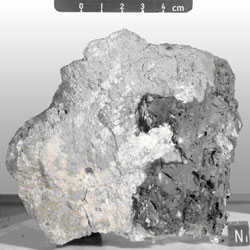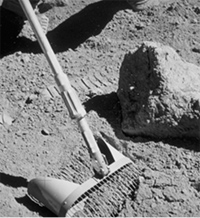Lunar Rocks and Soils from Apollo Missions

A one-Kg (2.2 lbs) Apollo 16 breccia rock formed from meteorite impact. Shiny, black impact-generated glass was splashed on the side.
Between 1969 and 1972 six Apollo missions brought back 382 kilograms (842 pounds) of lunar rocks, core samples, pebbles, sand and dust from the lunar surface. The six space flights returned 2200 separate samples from six different exploration sites on the Moon. In addition, three automated Soviet spacecraft returned important samples totaling 300 grams (approximately 3/4 pound) from three other lunar sites. The lunar sample building at Johnson Space Center is the chief repository for the Apollo samples. The lunar sample laboratory is where pristine lunar samples are prepared for shipment to scientists and educators. Nearly 400 samples are distributed each year for research and teaching projects.
Astronaut collecting lunar soil sample.
Study of rock and soil samples from the Moon continues to yield useful information about the early history of the Moon, the Earth, and the inner solar system. Recent computer models indicate that the Moon could have been formed from the debris resulting from the Earth being struck a glancing blow by a planetary body about the size of Mars. The chemical composition of the Moon, derived from studies of lunar rocks, is compatible with this theory of the origin of the Moon. We have learned that a crust formed on the Moon 4.4 billion years ago. This crust formation, the intense meteorite bombardment occurring afterward, and subsequent lava outpourings are recorded in the rocks. Radiation spewed out by the Sun since the formation of the Moon's crust, was trapped in the lunar soil as a permanent record of solar activity throughout this time.

